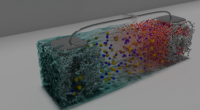(a) Both A and R are true and R is the correct explanation of A
(b) Both A and R are true but l. is not a correct explanation of A
(c) A is true but R is false
(d) A is false but R is true
(b) Both A and R are true but l. is not a correct explanation of A
(c) A is true but R is false
(d) A is false but R is true
1. Assertion (A): The degeneration of tadpole tail occurs during metamorphosis.
Reason (R): This degeneration is brought about by hydrolytic enzymes.
Ans. (a)
Reason (R): This degeneration is brought about by hydrolytic enzymes.
Ans. (a)
2. Assertion (A): Geological evidence indicates that free oxygen began accumulating in the atmosphere about two billion year ago.
Reason (R): The free oxygen in the atmosphere is produced by cyanobacteria like forms.
Ans. (d)
Reason (R): The free oxygen in the atmosphere is produced by cyanobacteria like forms.
Ans. (d)
3. Assertion (A): Thalassaemia is a dreaded disease of blood caused by structural variations in or globin chains.
Reason (R): Structural variations in globin chains are due to amino acid replacements.
Ans. (a)
Reason (R): Structural variations in globin chains are due to amino acid replacements.
Ans. (a)
4. Assertion (A): Prokaryote cells prolife-rate at a much more rapid rate than eukaryotes.
Reason (R): In prokaryotes there is no condensation of the chromosomes, no spindle apparatus and they follow a simple duplication and separation of DNA pattern.
Ans. (a)
Reason (R): In prokaryotes there is no condensation of the chromosomes, no spindle apparatus and they follow a simple duplication and separation of DNA pattern.
Ans. (a)
5. Assertion (A): Each gene can exist in a variety of different forms called alleles.
Reason (R): Different alleles of the same gene arise by heritable changes (mutations) in the gene itself.
Ans. (a)
Reason (R): Different alleles of the same gene arise by heritable changes (mutations) in the gene itself.
Ans. (a)
6. Assertion (A): Pila produces two types of sperm, namely eupyrene and oligopyrene.
Reason (R): Eupyrene sperm has XX chromosomes and can produce only female while oligopyrene sperm has XV chromosomes and can produce only male.
Ans. (c)
Reason (R): Eupyrene sperm has XX chromosomes and can produce only female while oligopyrene sperm has XV chromosomes and can produce only male.
Ans. (c)
7. Assertion (A): Echinodermata and Hemichordata are both deuterostomes.
Reason (R): During early development of these ‘phyla, the blastopore becomes the mouth opening.
Ans. (c)
Reason (R): During early development of these ‘phyla, the blastopore becomes the mouth opening.
Ans. (c)
8. Assertion (A): Bryozoa is now divided into two separate phylaendoprocta and Ectoprocta
Reason (R): Though Endoprocta has some superficial similarities with Ectoprocta, the former is acoelomate and the latter acoelomate.
Ans. (c)
Reason (R): Though Endoprocta has some superficial similarities with Ectoprocta, the former is acoelomate and the latter acoelomate.
Ans. (c)
9. Assertion (A): The ‘killer’ stains of Paramecium aurelia produce a toxic substance (paramecin) which kills the ‘sensitive’ ones.
Reason (R): Such ‘killer’ stains lack the Kappa particles.
Ans. (c)
Reason (R): Such ‘killer’ stains lack the Kappa particles.
Ans. (c)
10. Assertion (A): The adults of echinoderms generally exhibit pentamerous radial symmetry.
Reason (R): A unique ambulacral system is typically present in echinoderms.
Ans. (b)
Reason (R): A unique ambulacral system is typically present in echinoderms.
Ans. (b)
11. Assertion (A): Balanoglossus is not a chordate.
Reason (R): The so-called notochord of Balanoglossus is only pre-oral extension of the gut.
Ans. (a)
Reason (R): The so-called notochord of Balanoglossus is only pre-oral extension of the gut.
Ans. (a)
12. Assertion (A): In birds, the synsacrum is fused with the pelvic girdle.
Reason (R): The synsacrum provides a rigid framework for perching.
Ans. (c)
Reason (R): The synsacrum provides a rigid framework for perching.
Ans. (c)
13. Assertion (A): The accidental leak of methyl isocyanate from a storage tank of a factory in Bhopal in 1980 killed more than 25, 000 people.
Reason (R): In the factory, the safety scrubber chimneys, filled with the detoxifying solution failed to function.
Ans. (c)
Reason (R): In the factory, the safety scrubber chimneys, filled with the detoxifying solution failed to function.
Ans. (c)
14. Assertion (A): After removal of parathyroids in lizards the blood calcium level rises rapidly.
Reason (R): Parathyroids regulate the level of calcium in blood.
Ans. (d)
Reason (R): Parathyroids regulate the level of calcium in blood.
Ans. (d)
15. Assertion (A): Linoleic acid and linolenic acid are essential polyunsaturated fatty acids.
Reason (R): Linoleic acid and linolenic acid are biosynthesized in human beings.
Ans. (c)
Reason (R): Linoleic acid and linolenic acid are biosynthesized in human beings.
Ans. (c)
16. Assertion (A): As a fuel, coal releases two-thirds more carbon dioxide per unit of energy than floes gasoline.
Reason (R): Coal is largely carbon, whereas gaso-line contains more hydrogen.
Ans. (a)
Reason (R): Coal is largely carbon, whereas gaso-line contains more hydrogen.
Ans. (a)
17. Assertion (A): In pearl oyster, it is the necre, which forms the pearl.
Reason (R): Necre is secreted continuously by the edge of the mantle.
Ans. (b)
Reason (R): Necre is secreted continuously by the edge of the mantle.
Ans. (b)
18. Assertion (A): Queen bee after mating produces both fertilized and unfertilized eggs.
Reason (R): Fertilized eggs produce queen and drones (males), whereas unfertilized eggs are eaten up. by the workers.
Ans. (c)
Reason (R): Fertilized eggs produce queen and drones (males), whereas unfertilized eggs are eaten up. by the workers.
Ans. (c)
19. Assertion (A): Puffs in the polytene chromosomes are the sites of gene transcription.
Reason (R): DNA unfolds into open loop to facilitate RNA synthesis in the puff.
Ans. (a)
Reason (R): DNA unfolds into open loop to facilitate RNA synthesis in the puff.
Ans. (a)
20. Assertion (A): Enlargement of spleen in a malarial patient is due to hemorrhage of arteries.
Reason (R): Infective states of Plasmodium are responsible for causing excessive proliferation of erythrocytes.
Ans. (d)
Reason (R): Infective states of Plasmodium are responsible for causing excessive proliferation of erythrocytes.
Ans. (d)
21. Assertion (A): Miracidium larva of Fasciola is endowed with cilia, penetration gland and apical gland.
Reason (R): The structure of miracidium is best adapted to penetrate into the liver and gall-bladder of sheep.
Ans. (c)
Reason (R): The structure of miracidium is best adapted to penetrate into the liver and gall-bladder of sheep.
Ans. (c)
22. Assertion (A): A cell placed in an isotonic solution shows no change in size or volume.
Reason (R): Isotonic solutions have the same chemical composition as the cell cytoplasm.
Ans. (c)
Reason (R): Isotonic solutions have the same chemical composition as the cell cytoplasm.
Ans. (c)
23. Assertion (A): Cardiac muscle cells contain much large amounts of RNA than pancreatic cells.
Reason (R): High-protein-producing cells contain larger amount of RNA in comparison to low protein producing cells.
Ans. (d)
Reason (R): High-protein-producing cells contain larger amount of RNA in comparison to low protein producing cells.
Ans. (d)
24. Assertion (A): Responses mediated by peptide hormones such as insulin are relatively slow.
Reason (R): The polypeptide hormones are rapidly removed from the blood by hydrolytic enzymes.
Ans. (c)
Reason (R): The polypeptide hormones are rapidly removed from the blood by hydrolytic enzymes.
Ans. (c)
25. Assertion (A): Myoglobin bears an iron-containing haem group capable of combining reversibly with oxygen.
Reason (R): Myoglobin is made up of a monomeric polypeptide chain without a tertiary structure.
Ans. (c)
Reason (R): Myoglobin is made up of a monomeric polypeptide chain without a tertiary structure.
Ans. (c)

